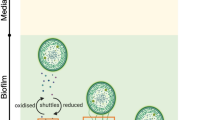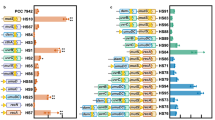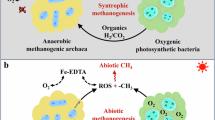Abstract
The relative abundance of transcripts encoding proteins involved in inorganic carbon concentrating mechanisms (CCM), detoxification of reactive oxygen species (ROS) and photosynthesis in the thermophilic cyanobacterium Synechococcus OS-B′ was measured in hot spring microbial mats over two diel cycles, and was coupled with in situ determinations of incoming irradiance and microenvironmental dynamics of O2 and pH. Fluctuations in pH and O2 in the mats were largely driven by the diel cycle of solar irradiance, with a pH variation from ∼7.0 to ∼9.5, and O2 levels ranging from anoxia to supersaturation during night and day, respectively. Levels of various transcripts from mat cyanobacteria revealed several patterns that correlated with incident irradiance, O2 and pH within the mat matrix. Transcript abundances for most genes increased during the morning dark–light transition. Some transcripts remained at a near constant level throughout the light period, whereas others showed an additional increase in abundance as the mat underwent transition from low-to-high light (potentially reflecting changes in O2 concentration and pH), followed by either a decreased abundance in the early afternoon, or a gradual decline during the early afternoon and into the evening. One specific transcipt, psbA1, was the lowest during mid-day under high irradiance and increased when the light levels declined. We discuss these complex in situ transcriptional patterns with respect to environmental and endogenous cues that might impact and regulate transcription over the diel cycle.
Similar content being viewed by others
Log in or create a free account to read this content
Gain free access to this article, as well as selected content from this journal and more on nature.com
or
Accession codes
References
Allewalt JP, Bateson MM, Revsbech NP, Slack K, Ward DM . (2006). Effect of temperature and light on growth of and photosynthesis by Synechococcus isolates typical of those predominating in the Octopus spring microbial mat community of Yellowstone National Park. Appl Environ Microbiol 72: 544–550.
Aro E-M, Suorsa M, Rokka A, Allahverdiyeva Y, Paakkarinen V, Saleem A et al. (2005). Dynamics of photosystem II: a proteomic approach to thylakoid protein complexes. J Exp Bot 56: 347–356.
Badger MR, Price GD . (1990). Carbon oxysulfide is an inhibitor of both CO2 and HCO3− uptake in the cyanobacterium Synechococcus PCC7942. Plant Physiol 94: 35–39.
Bhaya D, Grossman AR, Steunou A-S, Khuri N, Cohan FM, Hamamura N et al. (2007). Population level functional diversity in a microbial community revealed by comparative genomic and metagenomic analyses. ISME J 1: 703–713.
Bouchard JN, Roy S, Campbell DA . (2006). UVB effects on the photosystem II-D1 protein of phytoplankton and natural phytoplankton communities. Photochem Photobiol 82: 936–951.
Brock TD . (1967). Relationship between standing crop and primary productivity along a hot spring thermal gradient. Ecology 48: 566–571.
Dayer R, Fischer BB, Eggen RIL, Lemaire SD . (2008). The peroxiredoxin and glutathione peroxidase families in Chlamydomonas reinhardtii. Genetics 179: 41–57.
de Beer D, Glud A, Epping E, Kühl M . (1997). A fast-responding CO2 microelectrode for profiling sediments, microbial mats, and biofilms. Limnol Oceanogr 42: 1590–1600.
de Beer D, Kühl M . (2001). Interfacial microbial mats and biofilms. In: Boudreau BP, Jørgensen BB (eds). The Benthic Boundary Layer. Transport Processes and Biogeochemistry. Oxford University Press: New York, pp 374–394.
Folea IM, Zhang P, Nowaczyk MM, Ogawa T, Aro E-M, Boekema EJ . (2008). Single particle analysis of thylakoid proteins from Thermosynechococcus elongatus and Synechocystis 6803: localization of the CupA subunit of NDH-1. FEBS Lett 582: 249–254.
Goyer A, Haslekås C, Miginiac-Maslow M, Klein U, Le Marechal P, Jacquot J-P et al. (2002). Isolation and characterization of a thioredoxin-dependent peroxidase from Chlamydomonas reinhardtii. Eur J Biochem 269: 272–282.
Jamieson D, Chance B, Cadenas E, Boveris A . (1986). The relation of free radical production to hyperoxia. Annu Rev Physiol 48: 703–719.
Kanehisa M, Goto S . (2000). KEGG: Kyoto Encyclopedia of Genes and Genomes. Nucleic Acids Res 28: 27–30.
Kaplan A, Hagemann M, Bauwe H, Kahlon S, Ogawa T . (2008). Carbon acquisition by cyanobacteria: mechanisms, comparative genomics, and evolution. In: Herrero A, Flores E (eds). The Cyanobacteria. Molecular biology, Genomics and Evolution. Caister Academic Press: Norfolk, UK, pp 305–334.
Kilian O, Steunou A-S, Fazeli F, Bailey S, Bhaya D, Grossman AR . (2007). Responses of a thermophilic Synechococcus isolate from the microbial mat of octopus spring to light. Appl Environ Microbiol 73: 4268–4278.
Kim J-H, Suh KH . (2005). Light-dependent expression of superoxide dismutase from cyanobacterium Synechocystis sp. strain PCC 6803. Arch Microbiol 183: 218–223.
Koropatkin NM, Koppenaal DW, Pakrasi HB, Smith TJ . (2007). The structure of a cyanobacterial bicarbonate transport protein, CmpA. J Biol Chem 282: 2606–2614.
Krieger-Liszkay A, Fufezan C, Trebst A . (2008). Singlet oxygen production in photosystem II and related protection mechanism. Photosynth Res 98: 551–564.
Kühl M, Lassen C, Revsbech NP . (1997). A simple light meter for measurements of PAR (400 to 700 nm) with fiber-optic microprobes: application for P vs E0 (PAR) measurements in a microbial mat. Aquat Microb Ecol 13: 197–207.
Kühl M, Revsbech NP . (2001). Biogeochemical microsensors for boundary layer studies. In: Boudreau BP, Jørgensen BB (eds). The Benthic Boundary Layer. Transport Processes and Biogeochemistry. Oxford University Press: New York, pp 180–210.
Latifi A, Ruiz M, Zhang C-C . (2009). Oxidative stress in cyanobacteria. FEMS Microbiol Rev 33: 258–278.
Li H, Singh AK, McIntyre LM, Sherman LA . (2004). Differential gene expression in response to hydrogen peroxide and the putative PerR regulon of Synechocystis sp. strain PCC 6803. J Bacteriol 186: 3331–3345.
Li Q, Canvin DT . (1998). Energy sources for HCO3− and CO2 transport in air-grown cells of Synechococcus UTEX 625. Plant Physiol 116: 1125–1132.
Maeda S-i, Badger MR, Price GD . (2002). Novel gene products associated with NdhD3/D4-containing NDH-1 complexes are involved in photosynthetic CO2 hydration in the cyanobacterium, Synechococcus sp. PCC7942. Mol Microbiol 43: 425–435.
Marcus Y, Harel E, Kaplan A . (1983). Adaptation of the cyanobacterium Anabaena variabilis to low CO2 concentration in their environment. Plant Physiol 71: 208–210.
McGinn PJ, Price GD, Badger MR . (2004). High light enhances the expression of low-CO2-inducible transctipts involved in the CO2-concentrating mechanism in Synechocystis sp. PCC6803. Plant Cell Environ 27: 615–626.
McGinn PJ, Price GD, Maleszka R, Badger MR . (2003). Inorganic carbon limitation and light control the expression of transcripts related to the CO2-concentrating mechanism in the cyanobacterium Synechocystis sp. strain PCC6803. Plant Physiol 132: 218–229.
McKay RML, Gibbs SP, Espie GS . (1993). Effect of dissolved inorganic carbon on the expression of carboxysomes, localization of Rubisco and the mode of inorganic carbon transport in cells of the cyanobacterium Synechococcus UTEX 625. Arch Microbiol 159: 21–29.
Nishimura T, Takahashi Y, Yamaguchi O, Suzuki H, Maeda S, Omata T . (2008). Mechanism of low CO2-induced activation of the cmp bicarbonate transporter operon by a LysR family protein in the cyanobacterium Synechococcus elongatus strain PCC 7942. Mol Microbiol 68: 98–109.
Nishiyama Y, Yamamoto H, Allakhverdiev SI, Inaba M, Yokota A, Murata N . (2001). Oxidative stress inhibits the repair of photodamage to the photosynthetic machinery. EMBO J 20: 5587–5594.
Oelze M-L, Kandlbinder A, Dietz K-J . (2008). Redox regulation and overreduction control in the photosynthesizing cell: complexity in redox regulatory networks. Biochim Biophys Acta 1780: 1261–1272.
Ogawa T, Miyano A, Inoue Y . (1985). Photosystem-I-driven inorganic carbon transport in the cyanobacterium, Anacystis nidulans. Biochim Biophys Acta 808: 77–84.
Omata T, Gohta S, Takahashi Y, Harano Y, Maeda S-I . (2001). Involvement of a CbbR homolog in low CO2-induced activation of the bicarbonate transporter operon in cyanobacteria. J Bacteriol 183: 1891–1898.
Omata T, Price GD, Badger MR, Okamura M, Gohta S, Ogawa T . (1999). Identification of an ATP-binding cassette transporter involved in bicarbonate uptake in the cyanobacterium Synechococcus sp. strain PCC 7942. Proc Natl Acad Sci USA 96: 13571–13576.
Price GD, Badger MR, Woodger FJ, Long BM . (2008). Advances in understanding the cyanobacterial CO2-concentrating-mechanism (CCM): functional components, Ci transporters, diversity, genetic regulation and prospects for engineering into plants. J Exp Bot 59: 1441–1461.
Price GD, Woodger FJ, Badger MR, Howitt SM, Tucker L . (2004). Identification of a SulP-type bicarbonate transporter in marine cyanobacteria. Proc Natl Acad Sci USA 101: 18228–18233.
Raven JA, Giordano M, Beardall J . (2008). Insights into the evolution of CCMs from comparisons with other resource acquisition and assimilation processes. Physiol Plant 133: 4–14.
Revsbech NP . (1989). An oxygen microsensor with a guard cathode. Limnol Oceanogr 34: 474–478.
Ritchie R . (1991). Membrane-potential and pH control in the cyanobacterium Synechococcus R-2 (Anacystis nidulans) PCC 7942. J Plant Physiol 137: 409–418.
Sarkar N, Lemaire S, Wu-Scharf D, Issakidis-Bourguet E, Cerutti H . (2005). Functional specialization of Chlamydomonas reinhardtii cytosolic thioredoxin h1 in the response to alkylation-induced DNA damage. Eukaryot Cell 4: 262–273.
Savage DF, Afonso B, Chen AH, Silver PA . (2010). Spatially ordered dynamics of the bacterial carbon fixation machinery. Science 327: 1258–1261.
Schaefer MR, Golden SS . (1989). Differential expression of members of a cyanobacterial psbA gene family in response to light. J Bacteriol 171: 3973–3981.
Shibata M, Ohkawa H, Kaneko T, Fukuzawa H, Tabata S, Kaplan A et al. (2001). Distinct constitutive and low-CO2-induced CO2 uptake systems in cyanobacteria: genes involved and their phylogenetic relationship with homologous genes in other organisms. Proc Natl Acad Sci USA 98: 11789–11794.
Steunou A-S, Bhaya D, Bateson MM, Melendrez MC, Ward DM, Brecht E et al. (2006). In situ analysis of nitrogen fixation and metabolic switching in unicellular thermophilic cyanobacteria inhabiting hot spring microbial mats. Proc Natl Acad Sci USA 103: 2398–2403.
Steunou A-S, Jensen SI, Brecht E, Becraft ED, Bateson MM, Kilian O et al. (2008). Regulation of nif gene expression and the energetics of N2 fixation over the diel cycle in a hot spring microbial mat. ISME J 2: 364–378.
Takahashi S, Murata N . (2008). How do environmental stresses accelerate photoinhibition? Trends Plant Sci 13: 178–182.
Tchernov D, Helman Y, Keren N, Luz B, Ohad I, Reinhold L et al. (2001). Passive entry of CO2 and its energy-dependent intracellular conversion to HCO3− in cyanobacteria are driven by a photosystem I-generated ΔμH+. J Biol Chem 276: 23450–23455.
Tchernov D, Silverman J, Luz B, Reinhold L, Kaplan A . (2003). Massive light-dependent cycling of inorganic carbon between oxygenic photosynthetic microorganisms and their surroundings. Photosynth Res 77: 95–103.
Teske AP, Stahl D . (2002). Microbial mats and biofilms: evolution, structure, and function of fixed microbial communities. In: Staley JT, Reysenbach AL (eds). Biodiversity of Microbial Life: Foundations of Earth’ Biosphere. Wiley-Liss: New York, pp 49–100.
Thomas RC . (1978). Ion-sensitive intracellular microelectrodes: how to make and use them. Academic Press: London, New York.
Triantaphylides C, Havaux M . (2009). Singlet oxygen in plants: production, detoxification and signaling. Trends Plant Sci 14: 219–228.
Triantaphylides C, Krischke M, Hoeberichts FA, Ksas B, Gresser G, Havaux M et al. (2008). Singlet oxygen is the major reactive oxygen species involved in photooxidative damage to plants. Plant Physiol 148: 960–968.
Turpin DH, Miller AG, Canvin DT . (1984). Carboxysome content of Synechococcus leopoliensis (cyanophyta) in response to inorganic carbon. J Phycol 20: 249 253.
Vijayan V, Zuzow R, O’Shea EK . (2009). Oscillations in supercoiling drive circadian gene expression in cyanobacteria. Proc Natl Acad Sci USA 106: 22564–22568.
Volokita M, Zenvirth D, Kaplan A, Reinhold L . (1984). Nature of the inorganic carbon species actively taken up by the cyanobacterium Anabaena variabilis. Plant Physiol 76: 599–602.
Ward DM, Bateson MM, Ferris MJ, Kühl M, Wieland A, Koeppel A et al. (2006). Cyanobacterial ecotypes in the microbial mat community of mushroom spring (Yellowstone National Park, Wyoming) as species-like units linking microbial community composition, structure and function. Phil Trans R Soc B 361: 1997–2008.
Ward DM, Cohan FM, Bhaya D, Heidelberg JF, Kühl M, Grossman A . (2008). Genomics, environmental genomics and the issue of microbial species. Heredity 100: 207–219.
Ward DM, Ferris MJ, Nold SC, Bateson MM . (1998). A natural view of microbial biodiversity within hot spring cyanobacterial mat communities. Microbiol Mol Biol Rev 62: 1353–1370.
Whelan JA, Russell NB, Whelan MA . (2003). A method for the absolute quantification of cDNA using real-time PCR. J Immunol Methods 278: 261–269.
Wieland A, de Beer D, Damgaard LR, Kühl M, van Dusschoten D, Van As H . (2001). Fine-scale measurement of diffusivity in a microbial mat with nuclear magnetic resonance imaging. Limnol Oceanogr 46: 248–259.
Wieland A, Kühl M . (2006). Regulation of photosynthesis and oxygen consumption in a hypersaline cyanobacterial mat (Camargue, France) by irradiance, temperature and salinity. FEMS Microbiol Ecol 55: 195–210.
Wilson CL, Hinman NW, Cooper WJ, Brown CF . (2000a). Hydrogen peroxide cycling in surface geothermal waters of Yellowstone National Park. Environ Sci Tech 34: 2655–2662.
Wilson CL, Hinman NW, Sheridan RP . (2000b). Hydrogen peroxide formation and decay in iron-rich geothermal waters: the relative roles of abiotic and biotic mechanisms. Photochem Photobiol 71: 691–699.
Woodger FJ, Badger MR, Price GD . (2003). Inorganic carbon limitation induces transcripts encoding components of the CO2-concentrating mechanism in Synechococcus sp. PCC7942 through a redox-independent pathway. Plant Physiol 133: 2069–2080.
Woodger FJ, Badger MR, Price GD . (2005). Sensing of inorganic carbon limitation in Synechococcus PCC7942 is correlated with the size of the internal inorganic carbon pool and involves oxygen. Plant Physiol 139: 1959–1969.
Woodger FJ, Bryant DA, Price GD . (2007). Transcriptional regulation of the CO2-concentrating mechanism in a euryhaline, coastal marine cyanobacterium, Synechococcus sp. strain PCC 7002: role of NdhR/CcmR. J Bacteriol 189: 3335–3347.
Wyman M . (1999). Diel rhythms in ribulose-1,5-bisphosphate carboxylase/oxygenase and glutamine synthetase gene expression in a natural population of marine picoplanktonic cyanobacteria (Synechococcus spp.). Appl Environ Microbiol 65: 3651–3659.
Xu M, Ogawa T, Pakrasi HB, Mi H . (2008). Identification and localization of the CupB protein involved in constitutive CO2 uptake in the cyanobacterium, Synechocystis sp. strain PCC 6803. Plant Cell Physiol 49: 994–997.
Zeller T, Klug G . (2006). Thioredoxins in bacteria: functions in oxidative stress response and regulation of thioredoxin genes. Naturwissenschaften 93: 259–266.
Zhang P, Battchikova N, Jansen T, Appel J, Ogawa T, Aro E-M . (2004). Expression and functional roles of the two distinct NDH-1 complexes and the carbon acquisition complex NdhD3/NdhF3/CupA/Sll1735 in Synechocystis sp PCC 6803. Plant Cell 16: 3326–3340.
Acknowledgements
We thank the US National Park Service and personnel from the Yellowstone National Park for their permission to conduct this work (permit YELL-2058; MK) and their kind and helpful assistance. We also thank C Klatt, E Becraft and DM Ward for assistance and logistical help during the fieldtrips, F Fazeli for help in the laboratory, and D Gonzalez-Ballester and S Bailey for helpful inputs and discussions. This study was funded by an internationalization PhD grant from the Danish Research Council (MK), with additional support from the National Science Foundation (Frontiers in Integrative Biology Program Grant EF-0328698; ARG, DB, MK), the Danish Natural Science Research Council (MK) and the Carnegie Institution for Science (DB, ARG).
Author information
Authors and Affiliations
Corresponding author
Additional information
Supplementary Information accompanies the paper on The ISME Journal website
Rights and permissions
About this article
Cite this article
Jensen, S., Steunou, AS., Bhaya, D. et al. In situ dynamics of O2, pH and cyanobacterial transcripts associated with CCM, photosynthesis and detoxification of ROS. ISME J 5, 317–328 (2011). https://doi.org/10.1038/ismej.2010.131
Received:
Revised:
Accepted:
Published:
Issue date:
DOI: https://doi.org/10.1038/ismej.2010.131
Keywords
This article is cited by
-
In situ metabolomic- and transcriptomic-profiling of the host-associated cyanobacteria Prochloron and Acaryochloris marina
The ISME Journal (2018)
-
Trade-offs between microbiome diversity and productivity in a stratified microbial mat
The ISME Journal (2017)
-
Effects of temperature on growth, photophysiology, Rubisco gene expression in Prorocentrum donghaiense and Karenia mikimotoi
Ocean Science Journal (2016)
-
Temporal metatranscriptomic patterning in phototrophic Chloroflexi inhabiting a microbial mat in a geothermal spring
The ISME Journal (2013)
-
Dynamic cyanobacterial response to hydration and dehydration in a desert biological soil crust
The ISME Journal (2013)



